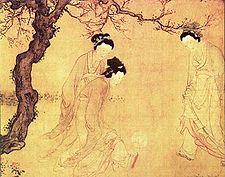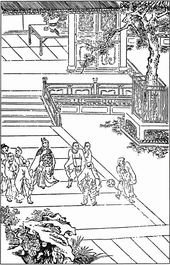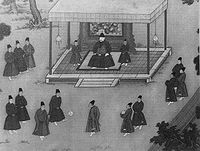
Cuju
Encyclopedia

Football
Football may refer to one of a number of team sports which all involve, to varying degrees, kicking a ball with the foot to score a goal. The most popular of these sports worldwide is association football, more commonly known as just "football" or "soccer"...
with similarities to association football. It is seen by some to be a forerunner of modern football and originated in China
China
Chinese civilization may refer to:* China for more general discussion of the country.* Chinese culture* Greater China, the transnational community of ethnic Chinese.* History of China* Sinosphere, the area historically affected by Chinese culture...
, and was also played in Korea
Korea
Korea ) is an East Asian geographic region that is currently divided into two separate sovereign states — North Korea and South Korea. Located on the Korean Peninsula, Korea is bordered by the People's Republic of China to the northwest, Russia to the northeast, and is separated from Japan to the...
, Japan
Japan
Japan is an island nation in East Asia. Located in the Pacific Ocean, it lies to the east of the Sea of Japan, China, North Korea, South Korea and Russia, stretching from the Sea of Okhotsk in the north to the East China Sea and Taiwan in the south...
and Vietnam
Vietnam
Vietnam – sometimes spelled Viet Nam , officially the Socialist Republic of Vietnam – is the easternmost country on the Indochina Peninsula in Southeast Asia. It is bordered by China to the north, Laos to the northwest, Cambodia to the southwest, and the South China Sea –...
.
History
The game of cuju was first mentioned in the Zhan Guo CeZhan Guo Ce
The Zhan Guo Ce is a renowned ancient Chinese historical work and compilation of sporadic materials on the Warring States Period compiled between the 3rd to 1st centuries BCE...
(under State of Qi's section) and later in the Sima Qian
Sima Qian
Sima Qian was a Prefect of the Grand Scribes of the Han Dynasty. He is regarded as the father of Chinese historiography for his highly praised work, Records of the Grand Historian , a "Jizhuanti"-style general history of China, covering more than two thousand years from the Yellow Emperor to...
's Shiji (under Su Qin
Su Qin
Su Qin , was an influential political strategist during the Warring States Period of Chinese history . He was born in Chengxuan Village, Luoyang in present day Henan Province. According to legend Su Qin was a disciple of Gui Guzi, the founder of the School of Diplomacy...
's biography), written during the Han Dynasty
Han Dynasty
The Han Dynasty was the second imperial dynasty of China, preceded by the Qin Dynasty and succeeded by the Three Kingdoms . It was founded by the rebel leader Liu Bang, known posthumously as Emperor Gaozu of Han. It was briefly interrupted by the Xin Dynasty of the former regent Wang Mang...
. Some claim that the Yellow Emperor
Yellow Emperor
The Yellow Emperor or Huangdi1 is a legendary Chinese sovereign and culture hero, included among the Three Sovereigns and Five Emperors. Tradition holds that he reigned from 2697–2597 or 2696–2598 BC...
invented the game for military training purposes, while others place its emergence during China's Warring States Period
Warring States Period
The Warring States Period , also known as the Era of Warring States, or the Warring Kingdoms period, covers the Iron Age period from about 475 BC to the reunification of China under the Qin Dynasty in 221 BC...
(476-221 BC). In any case, it certainly existed during this period. A competitive form of cuju was used as fitness training for military
Military
A military is an organization authorized by its greater society to use lethal force, usually including use of weapons, in defending its country by combating actual or perceived threats. The military may have additional functions of use to its greater society, such as advancing a political agenda e.g...
cavalier
Cavalier
Cavalier was the name used by Parliamentarians for a Royalist supporter of King Charles I and son Charles II during the English Civil War, the Interregnum, and the Restoration...
s, while other forms were played for entertainment in wealthy cities like Linzi
Linzi
Linzi was the capital of Qi from 859 BC to 221 BC during the Spring and Autumn Period and Warring States Period in China. The ruins of the city lie in modern day Linzi District, Shandong, China. The city was one of the largest and richest in China during the Spring and Autumn Period...
.
During the Han Dynasty
Han Dynasty
The Han Dynasty was the second imperial dynasty of China, preceded by the Qin Dynasty and succeeded by the Three Kingdoms . It was founded by the rebel leader Liu Bang, known posthumously as Emperor Gaozu of Han. It was briefly interrupted by the Xin Dynasty of the former regent Wang Mang...
(206 BC-AD 220
220
Year 220 was a leap year starting on Saturday of the Julian calendar. At the time, it was known as the Year of the Consulship of Antonius and Eutychianus...
), the popularity of cuju spread from the army to the royal courts and upper classes. It is said that the Han
Han Dynasty
The Han Dynasty was the second imperial dynasty of China, preceded by the Qin Dynasty and succeeded by the Three Kingdoms . It was founded by the rebel leader Liu Bang, known posthumously as Emperor Gaozu of Han. It was briefly interrupted by the Xin Dynasty of the former regent Wang Mang...
emperor Wu Di enjoyed the sport. At the same time, cuju games were standardized and rules were established. Football matches were often held inside the imperial palace. A type of court called ju chang was built especially for cuju matches, which had six crescent-shaped goal posts at each end.

Tang Dynasty
The Tang Dynasty was an imperial dynasty of China preceded by the Sui Dynasty and followed by the Five Dynasties and Ten Kingdoms Period. It was founded by the Li family, who seized power during the decline and collapse of the Sui Empire...
(618-907). First of all, the feather-stuffed ball was replaced by an air-filled ball with a two-layered hull. Also, two different types of goal posts emerged: One was made by setting up posts with a net between them and the other consisted of just one goal post in the middle of the field. The Tang Dynasty capital of Chang'an
Chang'an
Chang'an is an ancient capital of more than ten dynasties in Chinese history, today known as Xi'an. Chang'an literally means "Perpetual Peace" in Classical Chinese. During the short-lived Xin Dynasty, the city was renamed "Constant Peace" ; yet after its fall in AD 23, the old name was restored...
was filled with cuju football fields, in the backyards of large mansion
Mansion
A mansion is a very large dwelling house. U.S. real estate brokers define a mansion as a dwelling of over . A traditional European mansion was defined as a house which contained a ballroom and tens of bedrooms...
s, and some were even established in the grounds of the palaces. Soldiers who belonged to the imperial army and Gold Bird Guard often formed cuju football teams for the delight of the emperor and his court. The level of female cuju teams also improved. Records indicate that once a 17-year-old girl beat a team of army soldiers. Cuju football even became popular amongst the scholars and intellectuals, and if a courtier lacked skill in the game, he could pardon himself by acting as a scorekeeper.
Cuju flourished during the Song Dynasty
Song Dynasty
The Song Dynasty was a ruling dynasty in China between 960 and 1279; it succeeded the Five Dynasties and Ten Kingdoms Period, and was followed by the Yuan Dynasty. It was the first government in world history to issue banknotes or paper money, and the first Chinese government to establish a...
(960-1279) due to social and economic development, extending its popularity to every class in society. At that time, professional cuju players were quite popular, and the sport began to take on a commercial edge. Professional cuju players fell into two groups: One was trained by and performed for the royal court (unearthed copper mirrors and brush pots from the Song often depict professional performances) and the other consisted of civilians who made a living as cuju players.

Cuju organizations were set up in large cities called Qi Yun She or Yuan She – now known as the earliest professional cuju club – whose members were either cuju lovers or professional performers. Non-professional players had to formally appoint a professional as his or her teacher and pay a fee before becoming a member. This process ensured an income for the professionals, unlike cuju of the Tang Dynasty.
Gameplay

"Zhu Qiu" was commonly performed at court feasts celebrating the emperor's birthday or during diplomatic events. A competitive cuju match of this type normally consisted of two teams with 12-16 players on each side.
"Bai Da" became dominant during the Song Dynasty, a style that attached much importance to developing personal skills. Scoring goals became obsolete when using this method with the playing field enclosed using thread and players taking turns to kick the ball within these set limits. The number of fouls made by the players decided the winner. For example, if the ball was not passed far enough to reach other team members points were deducted. If the ball was kicked too far out, a large deduction from the score would result. Kicking the ball too low or turning at the wrong moment all led to fewer points. Players could touch the ball with any part of the body except their hands whilst the number of players ranged anywhere from two to ten. In the end, the player with the highest score won.
Cuju began to decline during the Ming Dynasty (1368–1644) due to neglect and the 2,000-year-old sport slowly faded away.
Cuju club
In the 10th century, a Cuju club Qi Yun She (齐云社) developed in China; every year there was a national championship Shan Yue Zheng Sai (山岳正赛) organised by Qi Yun She.Cultural references
- The Hong KongHong KongHong Kong is one of two Special Administrative Regions of the People's Republic of China , the other being Macau. A city-state situated on China's south coast and enclosed by the Pearl River Delta and South China Sea, it is renowned for its expansive skyline and deep natural harbour...
TVB series A Change of DestinyA Change of DestinyA Change of Destiny is a TVB costume drama series broadcast in April 2007.The series is about two young men having the same birthday but have both of them have a different life...
featured at least one episode based on the cuju competition. BaguaBagua (concept)The bagua are eight diagrams used in Taoist cosmology to represent the fundamental principles of reality, seen as a range of eight interrelated concepts. Each consists of three lines, each line either "broken" or "unbroken," representing yin or yang, respectively...
concepts were also used to jinx the opposing team. However it followed more of the modern football (soccer) rules than ancient rules of the game. - John WooJohn WooJohn Woo Yu-Sen SBS is a Hong Kong-based film director and producer. Recognized for his stylised films of highly choreographed action sequences, Mexican standoffs, and use of slow-motion, Woo has directed several notable Hong Kong action films, among them, A Better Tomorrow, The Killer, Hard...
's epic filmEpic filmAn epic is a genre of film that emphasizes human drama on a grand scale. Epics are more ambitious in scope than other film genres, and their ambitious nature helps to differentiate them from similar genres such as the period piece or adventure film...
Red Cliff features a cuju competition while Cao CaoCao CaoCao Cao was a warlord and the penultimate chancellor of the Eastern Han Dynasty who rose to great power during the dynasty's final years. As one of the central figures of the Three Kingdoms period, he laid the foundations for what was to become the state of Cao Wei and was posthumously titled...
and others observe on the sideline.
See also
- HarpastumHarpastumHarpastum, also known as Harpustum, was a form of ball game played in the Roman Empire. The Romans also referred to it as the small ball game. The ball used was small and hard, probably about the size and solidity of a softball...
- KnattleikrKnattleikrKnattleikr is an ancient ball game played by the Vikings of Iceland.-How the game was played:Today no one knows the game's exact rules but there is some information.We know that:*Players were divided into teams....
- La souleLa SouleLa soule, also known as choule, is a traditional team sport that originated in Normandy and Picardy.The ball, called a soule, could be solid or hollow and made of either wood or leather. Leather balls would be filled with hay, bran, horse hair or moss...
- Sepak takrawSepak takrawSepak takraw , or kick volleyball, is a sport native to the Malay-Thai Peninsula...
- List of Chinese inventions
- List of China-related topics

